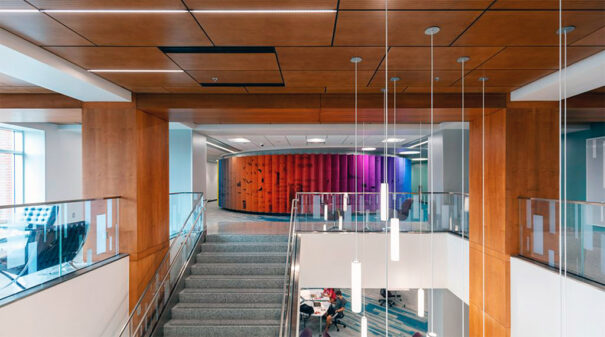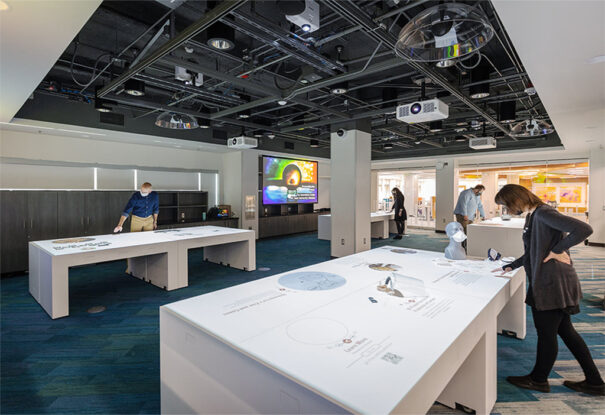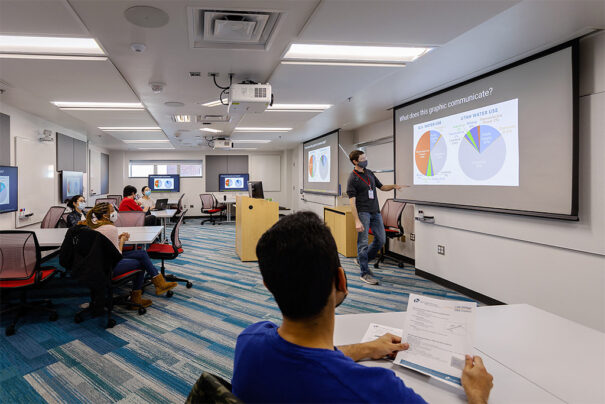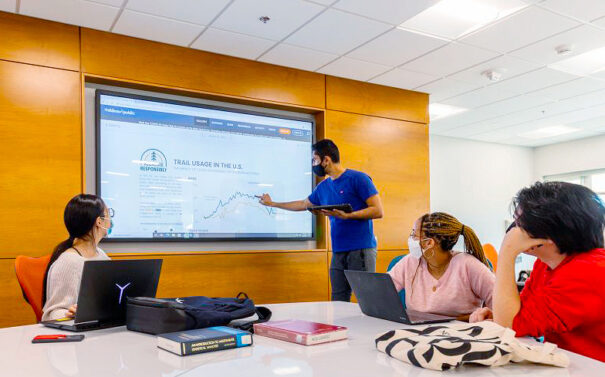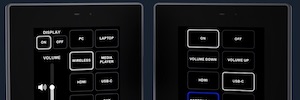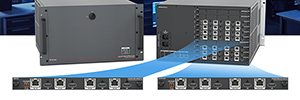Extron convierte la Biblioteca Hill en un centro de referencia para el aprendizaje
Los espacios de estas instalaciones pertenecientes a la NCSU que han incorporado soluciones de conmutación, distribución y control AV de Extron han sido el Visualization Studio, el Innovation Studio y el Data Experience Lab.
La Biblioteca D. H. Hill Jr. de la Universidad de Carolina del Norte (NCSU), que almacena más de un millón de libros, tiene el nombre de Daniel Harvey Hill, Jr., un profesor inglés que fue uno de los cinco primeros miembros del profesorado de la NCSU. Fue presidente de la universidad durante varios años a principios de 1900. La biblioteca fue construida en fases durante décadas y el edificio tuvo una renovación importante en 2021.
La renovación ha conllevado amplias remodelaciones a la estructura, y muchas adiciones y actualizaciones tecnológicas, incluyendo servicios audiovisuales. Esto convierte a la biblioteca Hill en un centro de referencia para el aprendizaje, la enseñanza, la investigación, la colaboración y la experimentación.
Los espacios en los que se ha incorporado la tecnología AV han sido el Innovation Studio, pensado para mostrar realidad virtual y otras tecnologías emergentes; el Visualization Studio, con proyección inmersiva de 360 grados; y el Data Experience Lab, un entorno de colaboración para la ciencia de datos, visualización y analítica.
También se incluyeron en la renovación más salas de estudio para grupos, laboratorios de aprendizaje y espacios para presentaciones que aumentaron la existente dotación de estas estancias en la biblioteca.
La UNCW ha utilizado la tecnología de Extron en diferentes proyectos de sus instalaciones. Si utilizó la solución ControlScript y su sistema NAV en su nuevo edificio Veterans Hall (más información en Digital AV), ahora sus productos de conmutación, distribución y control AV han sido cruciales para el funcionamiento de todos estos espacios de la Biblioteca Hill.
El equipo AV interno de la NCSU tomó la decisión de implementar la conmutación, distribución y control AV de Extron en la Biblioteca Hill, en parte porque ya utilizaban su software GlobalViewer Enterprise para gestionar sus amplias instalaciones de sistemas de Extron en muchos de los otros espacios de aprendizaje de la universidad.
Visualization Studio
El Visualization Studio es un teatro con escenario circular inmersivo, diseñado para mostrar el contenido que producen la universidad y estudiantes de todo el campus.
Ocho proyectores y doce altavoces entregan vídeo de 360 grados y un envolvente sonido surround Dolby Atmos para una convincente enseñanza y aprendizaje, charlas de investigación, proyectos especiales y eventos.
Una matriz de conmutación XTP II CrossPoint 1600 de 16×16 es utilizada para seleccionar y distribuir contenido de programa y señales de control a través de cables de par trenzado blindado a los proyectores. Un receptor XTP en cada proyector proporciona señales de vídeo HDMI y de control RS-232 a los proyectores.
El sistema de audio incluye los amplificadores XPA U 1002-70V y NetPA 1001-70V AT. Estos entregan sonido desde fuentes analógicas y Dante a un amplio sistema de altavoces de techo y pared, que incluye siete altavoces de montaje en superficie SM 28T, en la pared circular que rodea a la audiencia, y cuatro altavoces colgantes SF 26PT suspendidos del techo.
Las funciones AV y de iluminación en la sala se manejan a través de una interfaz de pantalla táctil en un mini iPad con la aplicación Extron Control. Respondiendo a las selecciones de la pantalla táctil, un procesador de control IPCP Pro 555 controla todos los componentes del sistema AV, mientras que un IPCP Pro 250 controla la iluminación de la sala.
Innovation Studio
El Innovation Studio es un espacio de aprendizaje que muestra el trabajo de estudiantes y la facultad utilizando una novedosa experiencia de proyección interactiva.
Superficies de proyección de 3×1,5 metros aparecen sobre las cuatro mesas de cada uno de los cuadrantes del estudio. Un proyector láser 4K en el techo, por encina de cada mesa, apunta hacia abajo, proporcionando contenido sobre cada mesa.
Una cámara de profundidad reconoce los movimientos de la mano del usuario en el espacio 3D sobre las mesas según estos interactúan con lo que se proyecta, emulando una pantalla táctil, pero sin ‘tocar’.
La experiencia se lleva a cabo con el software de Relative Scale LLC, una firma de Raleigh con múltiples alumnos de la NCSU entre su personal.
El espacio puede reconfigurarse para presentar talleres y eventos apagando las exhibiciones y moviendo las mesas de ruedas. Tres proyectores estándar con pantallas desplegables se utilizan para las presentaciones.
De nuevo, una matriz de conmutación XTP II CrossPoint 1600 y receptores HDMI XTP SR HD 4K manejan la conmutación y distribución AV a los proyectores y sistema de sonido.
El contenido para las cuatro mesas de exhibición procede de cuatro ordenadores. El contenido para las presentaciones estándar procede de tres transmisores en placa mural HDMI XTP T HWP 101 4K.
Cinco amplificadores mono MPA 601 hacen funcionar diez altavoces montados en el techo sobre las mesas y en las zonas de presentación.
El funcionamiento del sistema AV es controlado desde una pantalla táctil TouchLink Pro TLP Pro 1220MG de 12″ montada en la pared a través de un procesador de control IPCP Pro 555.
Data Experience Lab y South Learning Lab
El Data Experience Lab y el South Learning Lab ofrecen herramientas para ayudar a los estudiantes y a la facultad a adquirir conocimientos en ciencia de datos e investigación digital.
Aquí, el personal de la biblioteca proporciona formación en cuanto a la organización y explotación de conjuntos de datos, creación de de datos utilizando gráficos de muchas formas, y el uso de metodologías geoespaciales. Los grupos del campus centrados en la ciencia de datos y la investigación digital también utilizan los espacios como centros de reuniones. Multimedia es clave para las técnicas de visualización de datos practicadas en estos laboratorios.
El Data Experience Lab se utiliza para demostraciones a grupos pequeños. El South Learning Lab está configurado como clase de aprendizaje activo tanto para grupos grandes como pequeños.
El primero incluye un dispositivo de visualización de pantalla plana táctil interactivo de 86 pulgadas. Un sistema de colaboración para espacios de reuniones HC 404 transmite vídeo y audio HDMI al dispositivo de visualización desde un ordenador, un punto de acceso inalámbrico o un conector HDMI en placa mural.
El puerto de la pantalla táctil del dispositivo de visualización de pantalla plana y su teclado y ratón inalámbricos se conectan al ordenador a través de una pareja de transmisor receptor USB Extender Plus. El control de usuario es a través de un panel de botones en red NBP 106 D montado en pared.
El South Learning Lab tiene muchas fuentes de contenido AV y dispositivos de visualización. Una matriz de conmutación XTP II CrossPoint 1600 es utilizada para seleccionar y distribuir contenido de programa y señales de control.
Los estudiantes pueden compartir contenido HDMI conectándose a uno de los seis transmisores en placa mural HDMI XTP T HWP 101 4K o a uno de los siete puntos de acceso inalámbrico.
El atril del instructor contiene una conexión de ordenador y una de HDMI de invitados, ambas proporcionan contenido a la matriz de conmutación a través de transmisores XTP. También hay disponible vídeo desde una cámara PTZ conectada al puerto USB de ordenador del atril. Los dos proyectores montados en el techo y los seis dispositivos de visualización de aprendizaje activo de 48 pulgadas reciben señales desde la matriz de conmutación XTP.
El sistema de audio de la sala incluye transmisiones de micrófonos de array de techo, micrófonos inalámbricos y audio de programa desde la matriz de conmutación a través de fuentes analógicas y de red Dante. Un amplificador MPA 601 hace funcionar los altavoces de la sala.
El sistema AV es controlado por un procesador de control IPCP Pro 555. Hay dos interfaces de usuario de pantalla táctil: una en el mini iPad con la aplicación Extron Control y la otra en la pantalla táctil TouchLink Pro TLP Pro 1220TG de 12 pulgadas de sobremesa del escritorio del instructor.
Salas de estudio en grupo
Las salas de estudio en grupo son lugares idóneos para compartir ideas. Cada una tiene cuatro asientos alrededor de una mesa, una pared lateral dedicada a una pizarra interactiva, y una delantera con un dispositivo de visualización de pantalla plana de 48 pulgadas.
Los participantes pueden compartir contenido HDMI con un sistema de colaboración para espacios de reuniones HC 402 a través de una conexión por cable al transmisor en placa mural HC 402 o de un punto de acceso inalámbrico.
Los usuarios controlan el sistema AV con el panel de botones NBP 106 D montado en la pared junto al transmisor en placa mural.
Te gustó este artículo?
Suscríbete a nuestro RSS feed y no te perderás nada.
• Sección: AV Conferencing, Casos de estudio, Control, Display, Distribución señales, Formación, Infraestructuras, Proyección, Telepresencia / Videoconferencia



